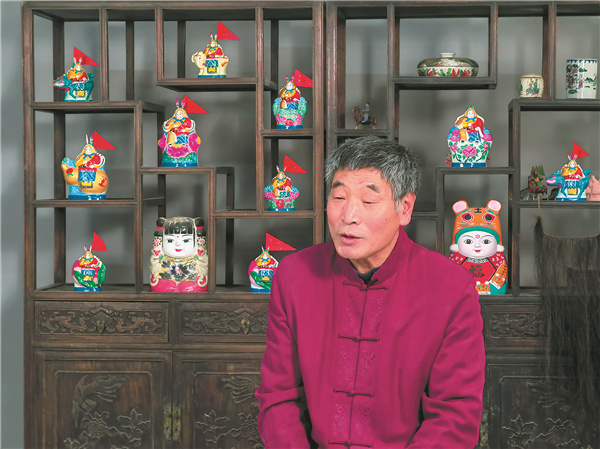

Modern context
He says he is most concerned about the fact that some of the rabbit figurines on the market have lost their traditional characteristics.
"Some major elements shouldn't be changed, otherwise it could cause misunderstandings of the story and folk customs behind it," he says.
For instance, he wants the public to understand the rabbit is actually a female.
"She borrowed a helmet and armor from a deity in a temple and dressed like a man for the convenience of treating patients in the then-feudal society," Shuang explains.
On the other hand, there can only be one flag behind her back, because legend has it that she was so tired, after going door to door to deliver medicines, that she rested under a temple flag, he adds.
"The story also reflects people's wish for, and pursuit of, health," he says.
Other taboos include the rabbit's steed, which can be a tiger, a deer or other auspicious animals and flowers, but never the dragon, which symbolizes ancient emperors.
However, Shuang is not against innovation within reason.
He does craft the figurines with new materials such as resin to make them lighter or to create detachable ears.
Last year, Shuang added Olympic elements to the traditional items. For example, he fashioned a rabbit god holding a ski pole, which was displayed at the Winter Games venues.
To preserve the old art, Shuang has taken several apprentices, including his son.
"There's no threshold to be my student; as long as you want to learn, I'm willing to teach," he says.
In addition, Shuang has actively joined various art events to promote Lord Rabbit culture.
Cheng Xiqi an office worker got a good measure of the tradition's charm at an art event in celebration of the Mid-Autumn Festival last year. "Shuang held our hands in the process of coloring the Lord Rabbit and drawing related accessories," Cheng recalls.
"The craftsmanship is impressive and so are the folk customs and culture behind it," she adds.
As many schools in Beijing have launched intangible cultural heritage programs in recent years, Shuang has readily taken on their invitations to present the art and skills, in a bid to inspire the younger generation's interest in the tradition.
So far, he has taught thousands of primary school students how to make the clay rabbits.
"Hopefully, some of them will learn all the skills associated with the craft from childhood and carry on this tradition."
Recently, Shuang initiated a project to systematically organize all the image and text resources on the Beijing painted clay sculptures.
"I hope that more people can come to know the real Beijing Tu'er Ye," he says.